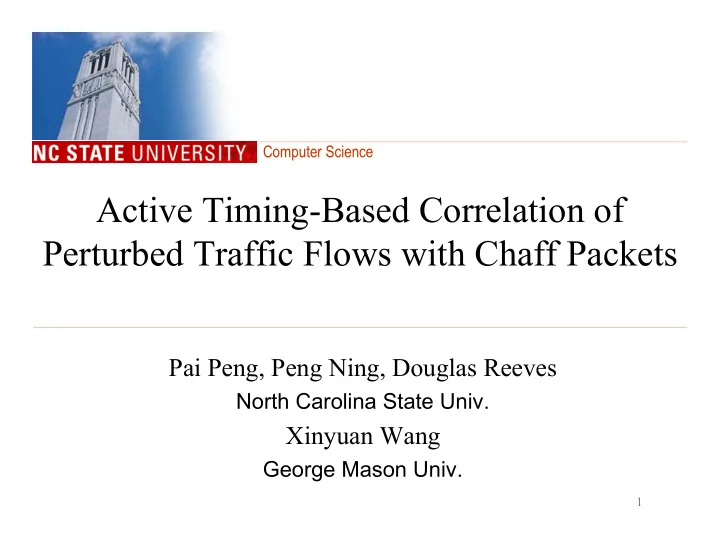

Computer Science Active Timing-Based Correlation of Perturbed Traffic Flows with Chaff Packets Pai Peng, Peng Ning, Douglas Reeves North Carolina State Univ. Xinyuan Wang George Mason Univ. 1
Attack Through Stepping Stones Telnet/ Attack Telnet/ Telnet/ Attack SSH SSH SSH Attacker Stepping Stepping Victim Victim Attacker Stepping Stone Stone Stone Chain of Stepping Stones Computer Science 2
Attack Trace-back • Stepping stone connection chain: – h 1 ↔ h 2 ↔ … ↔ h n • Stepping stone flows : – h 1 ↔ h 2 : h 1 → h 2 and h 2 ← h 1 – i < j, h i → h i+1 is called an upstream flow of h j → h j+1 , and h j → h j+1 is called a downstream flow of h i → h i+1 • Trace back problem: – Given an upstream flow, to identify its downstream flows. Computer Science 3
Attack Trace-back (cont’d) • Countermeasures: – Content encryption – Timing perturbations – Extra padding packets: Chaff Computer Science 4
Related Work • Correlation based on packet contents – Thumb-printing – Sleepy watermark tracing • Correlation based on timing characteristics – On/off periods – Deviation based – Watermark scheme based on Inter-packet delay (IPD) quantization – Multi-scale – Comparing the numbers of packets in the flows Computer Science 5
Related Work (cont’d) • Probabilistic watermark scheme – Embed watermark through slightly adjusting packet timing – Inter-packet-delay (IPD) of packet p j and p j+d is: ipd = t j+d – t j – Randomly construct 2r IPDs and divide them into 2 groups: ipd 1 and ipd 2 , the average difference between IPDs in group 1 and 2 is: – E(D) = 0 Computer Science 6
Probabilistic Watermarking (cont’d) Computer Science 7
Probabilistic Watermarking (cont’d) • Embed watermark – Embed bit 1: increase D • Increase IPDs in the 1 st group, and • Decrease IPDs in the 2 nd group. – Embed bit 0: decrease D • Decode watermark – Check whether D > 0 or D <= 0 • Robust to timing perturbation, but not chaff – Must known the location of watermark Computer Science 8
Related Work (cont’d) • Zhang et al.: – Finding possible matching packets – Different correlation schemes aiming at timing perturbation or/and chaff packets • Scheme S-IV Computer Science 9
Proposed Approach • Adopt probabilistic watermarking – Encode is ok, need to change decode • Basic idea: – Find possible matching packets – Decode watermarks from all possible matching flows. – Use the “best” watermark that has the smallest hamming distance to the original watermark to determine correlation result. – Can detect any flow that probabilistic watermark scheme can. • Assumptions: – No packet loss/merge through stepping stone connections. – The delays between corresponding packets are bounded by a maximum delay Δ ( timing constraint ). – The orders of packets are kept the same ( order constraint ). Computer Science 10
Matching Packets • For each packet p i in the upstream flow f , we find all its possible matching packets in the suspicious flow f’ : – Matching set: M( p i ) = { p j ’ | 0 <= t j ’ – t i <= Δ } – Matching sets may overlap Computer Science 11
Decoding the “Best” Watermark • Brute-force algorithm – high computation cost • Greedy algorithm : choose the packets that are most likely to produce the desired watermark. – Pros: • Low computation costs • Good detection rate – Cons: • High false positive rate Computer Science 12
Decoding the “Best” Watermark (cont’d) • Use Greedy algorithm to filter out the watermark bits that will not match. • Carefully construct a flow satisfying the order constraint, and decode a watermark w b . • Gradually improve w b by switching to other matching packets – Greedy+ : using heuristics • Adjust the watermark bit that has the smallest IPD difference D first • Cannot affect the bits that are already matched – Greedy* : enumerate all possible combinations of matching packets Computer Science 13
Experimental Evaluation • Compare the detection rates, false positive rates and computation costs of Greedy, Greedy+, Greedy*, probabilistic watermarking, and scheme S-IV. • Using both real flows and synthetic flows. Computer Science 14
Detection Rate Computer Science 15
False Positive Rate Computer Science 16
Computation Cost: Correlated Flows Computer Science 17
Computation Cost: Uncorrelated Flows Computer Science 18
Conclusion • A correlation scheme that can deal with both timing perturbation and chaff packets • Different algorithms to achieve the best performance in terms of detection rate, false positive rate and computation cost. • Through experimental evaluation, Greedy+ has shown the best result. Computer Science 19
Thank you! • Questions? Computer Science 20
Recommend
More recommend